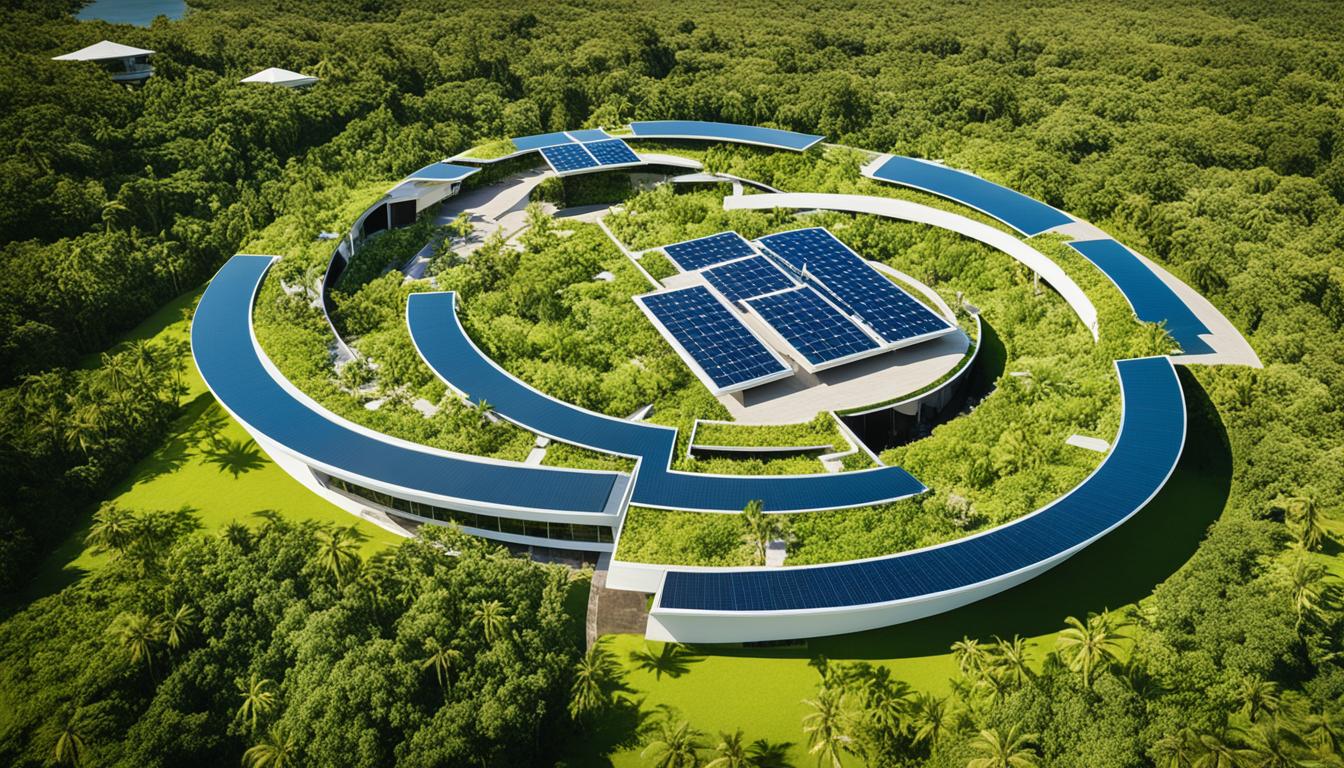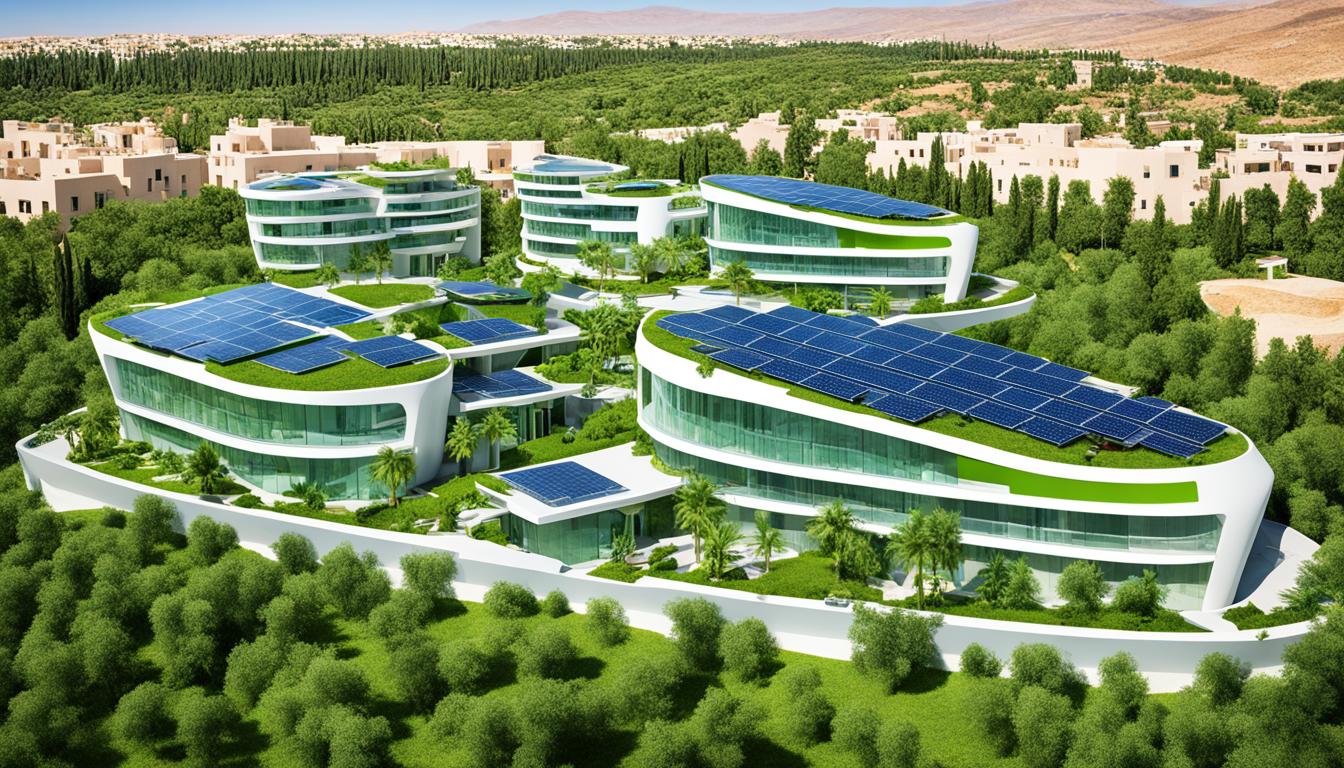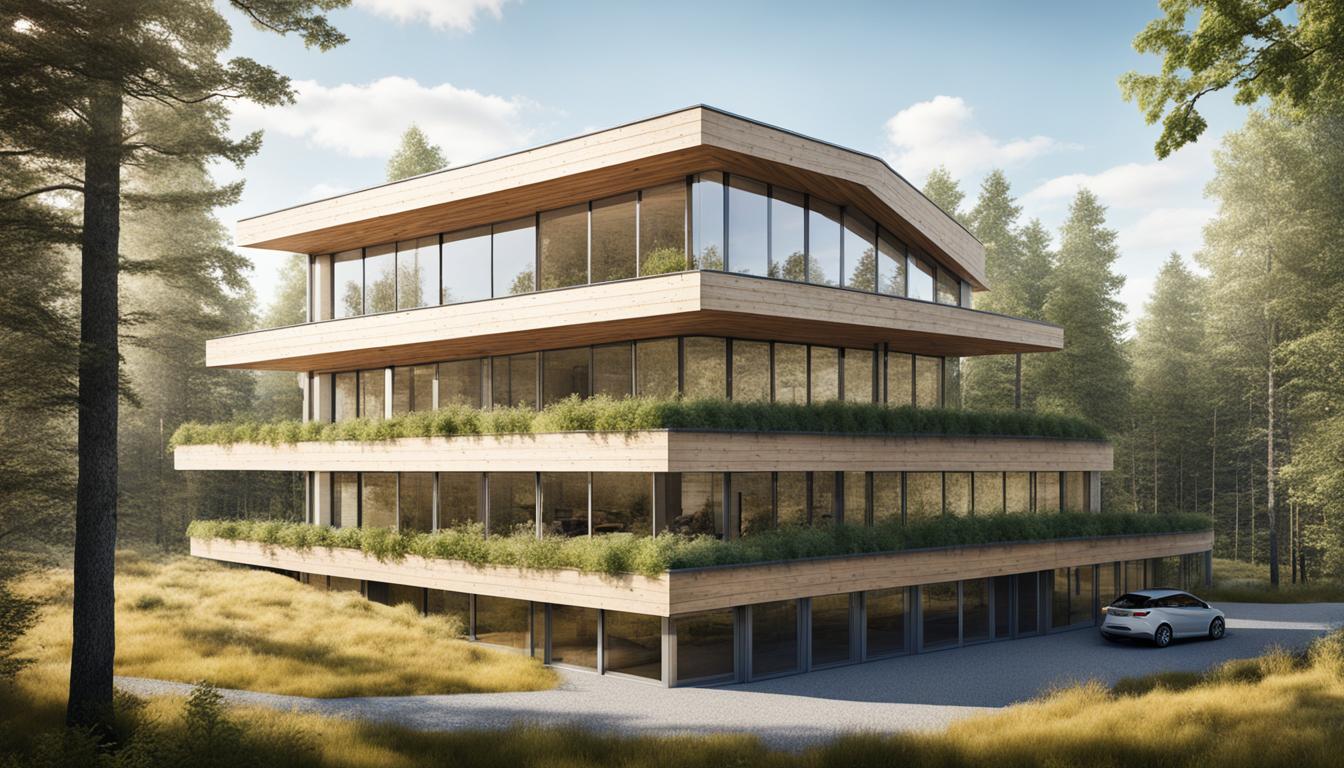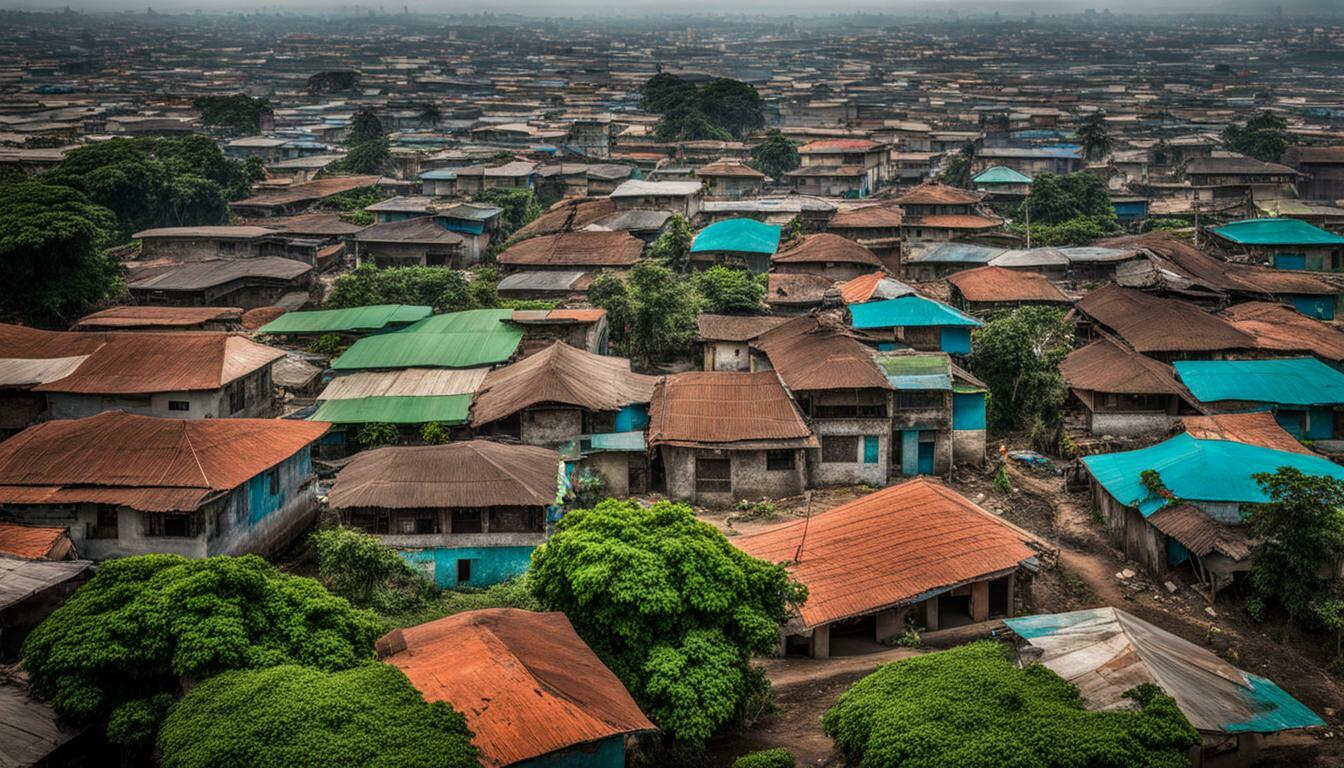Trinidad and Tobago Top Green Buildings
Trinidad and Tobago is at the forefront of sustainable design and innovation with its top green buildings. These buildings are known for their eco-friendly features and commitment to minimizing their impact on the environment. By incorporating energy-efficient practices and utilizing sustainable materials, green buildings in Trinidad and Tobago contribute to reducing energy consumption and carbon emissions in the Caribbean region.
Key Takeaways:
- Trinidad and Tobago is leading the way in sustainable architecture and design.
- Green buildings in Trinidad and Tobago prioritize energy efficiency and utilize sustainable materials.
- These buildings help reduce energy consumption and carbon emissions in the Caribbean region.
- Green buildings offer various benefits, including cost savings and improved indoor air quality.
- The government’s support and regulations play a key role in promoting green building practices.
The Importance of Green Buildings
As Trinidad and Tobago strives towards sustainable architecture and eco-friendly buildings, the importance of green buildings cannot be overstated. According to the Trinidad and Tobago Green Building Council (TTGBC), buildings in the Caribbean are responsible for nearly 40% of total energy consumption and 38% of carbon emissions. This highlights the urgent need for sustainable solutions to minimize environmental impact and promote a more sustainable built environment.
Green buildings are designed with a focus on energy and water efficiency, sustainable construction practices, and reducing their overall footprint. By implementing innovative design strategies, these buildings aim to minimize their environmental impact and promote a more sustainable future for Trinidad and Tobago.
One benchmark for green buildings is LEED certification, which follows a global benchmarking system for energy and environmental performance in buildings. LEED-certified buildings are recognized for their sustainable features and their commitment to minimizing their impact on the environment.
Benefits of Green Buildings in Trinidad and Tobago
Green buildings offer numerous benefits, both for the environment and the people who occupy them. They contribute to reducing energy consumption, lowering carbon emissions, and promoting a healthier living and working environment.
Some of the key benefits of eco-friendly buildings in Trinidad and Tobago include:
- Energy Efficiency: Green buildings are designed to maximize energy performance, resulting in reduced energy consumption and lower utility costs.
- Improved Indoor Air Quality: By incorporating proper ventilation and low-toxicity materials, green buildings provide occupants with healthier indoor air quality.
- Water Conservation: Green buildings implement water-efficient systems, such as rainwater harvesting and low-flow fixtures, to reduce water consumption.
- Sustainable Construction: These buildings utilize sustainable materials, reducing the environmental impact associated with construction.
- Resilience to Climate Change: Green buildings are designed to withstand the impacts of climate change, making them more resilient and adaptable to future challenges.
Impact on Sustainable Development
Green buildings play a crucial role in sustainable development in Trinidad and Tobago, contributing to a greener, more resilient future for the country.
By reducing energy consumption and carbon emissions, green buildings help mitigate climate change and its associated impacts. They also support the country’s goals of energy independence by reducing reliance on fossil fuels.
Furthermore, sustainable architecture in Trinidad and Tobago promotes the use of local materials and sustainable construction practices, driving economic growth and job creation in the green building industry.
Case Study: The OASIS (Opportunities for Advancement and Sustainability Through Informal Settlement Upgrading)
The OASIS project exemplifies the potential of sustainable architecture and eco-friendly buildings in Trinidad and Tobago.
This innovative project aims to improve the living conditions in informal settlements through the construction of sustainable and affordable housing solutions. The OASIS homes are designed to be energy-efficient, incorporating passive cooling strategies, solar panels for electricity generation, and rainwater harvesting systems.
| Key Features of OASIS Sustainable Homes | Benefits |
|---|---|
| Passive Cooling Strategies | Reduces the need for artificial cooling, resulting in lower energy consumption and cost savings. |
| Solar Panels | Generates clean energy, reducing reliance on fossil fuels and lowering electricity bills. |
| Rainwater Harvesting Systems | Collects and stores rainwater for non-potable uses, reducing water consumption and promoting sustainability. |
| Use of Sustainable Materials | Minimizes environmental impact by using locally sourced and sustainable construction materials. |
The OASIS project showcases the positive impact that sustainable architecture and eco-friendly buildings can have on communities, improving living conditions while minimizing the environmental impact.
Elements of Green Building Design
Green buildings incorporate various design elements to enhance energy performance. These elements take into account factors such as building location, orientation, shape, and envelope (roof, floor, walls, windows, and doors), all of which profoundly impact energy usage.
Proper shading and insulation are key considerations in green building design. By strategically positioning buildings and implementing shading devices such as overhangs or louvers, excessive heat gain from direct sunlight can be reduced, minimizing the need for artificial cooling and hence, lowering energy consumption.
“Sustainable design should always prioritize natural light and fresh air, especially in tropical regions like Trinidad and Tobago. Optimizing airflow and natural light not only reduces energy usage but also enhances the occupant’s comfort and well-being.” – Amanda Green, Architectural Designer
Energy-efficient appliances and fixtures are essential components of green buildings. These include LED lighting, smart thermostats, and high-efficiency HVAC systems, which greatly contribute to reducing energy demand and overall consumption.
The use of sustainable construction materials is a crucial aspect of green building design, especially in Tobago. Incorporating locally sourced materials not only supports the local economy but also helps reduce the environmental impact associated with transport. Examples of sustainable materials include bamboo, recycled metals, and low VOC (volatile organic compounds) paints, which contribute to improved indoor air quality.
Furthermore, optimizing airflow and natural light through design strategies such as implementing skylights, large windows, and open floor plans can reduce the need for artificial lighting and enhance the occupant’s connection to the outdoors.
Water conservation measures are also integrated into green building design. These measures include rainwater harvesting systems, low-flow fixtures, and efficient irrigation systems that minimize water wastage and promote sustainable water management practices.
The implementation of green building certifications in Trinidad adds credibility and ensures adherence to sustainable design standards. Certifications such as LEED (Leadership in Energy and Environmental Design) provide a globally recognized benchmark for evaluating the environmental performance of buildings.
Green Building Certifications
| Certification | Description |
|---|---|
| LEED (Leadership in Energy and Environmental Design) | A globally recognized certification system that evaluates the environmental performance of buildings and encourages sustainable design practices. |
| BREEAM (Building Research Establishment Environmental Assessment Method) | An international standard for assessing the sustainability of buildings, covering various categories such as energy, water, and materials. |
| Green Globes | A flexible certification program that focuses on sustainable design, operation, and management of buildings, providing a rating system for environmental performance. |
By implementing these design elements and pursuing green building certifications, Trinidad and Tobago can continue to lead the way in sustainable construction practices, ensuring a greener and more resilient built environment.
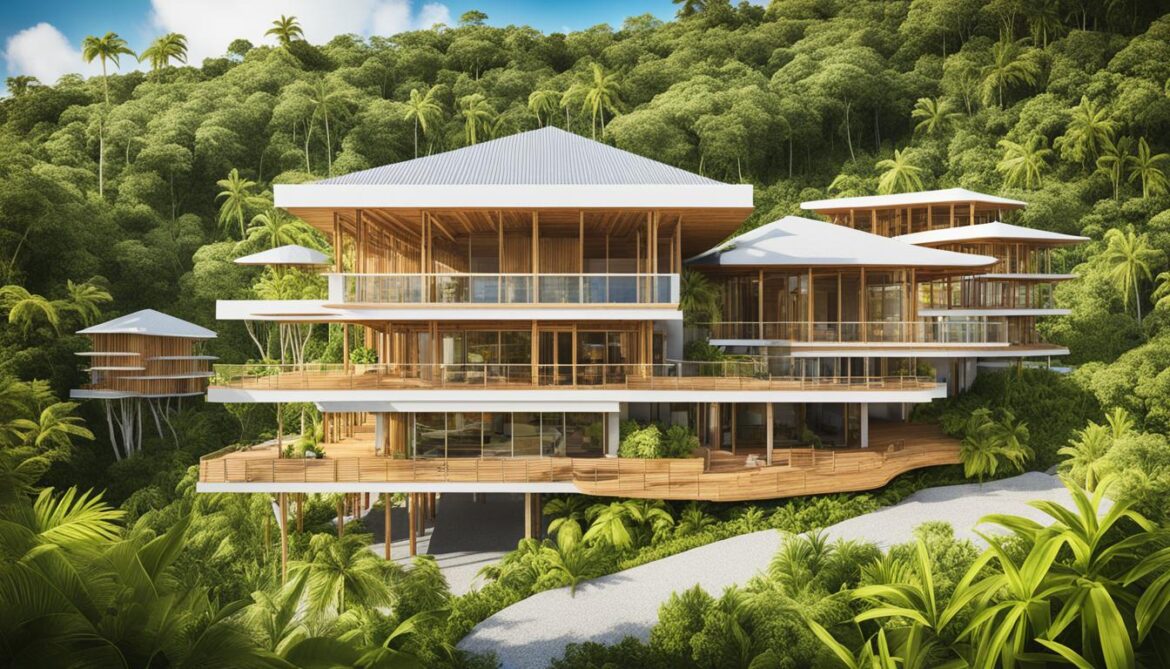
Benefits of Green Buildings
Green buildings offer multiple benefits to both occupants and the environment. They improve energy efficiency, leading to cost savings and reduced reliance on fossil fuels. Green buildings also contribute to improved indoor air quality, comfort, and productivity for occupants. Additionally, these buildings help reduce water consumption and minimize waste generation, leading to a more sustainable and environmentally-friendly built environment.
By incorporating energy-efficient technologies and sustainable design principles, green buildings in Tobago and Trinidad contribute to a more sustainable future. The use of renewable energy sources such as solar panels reduces dependence on traditional energy sources and lowers greenhouse gas emissions. Furthermore, well-insulated building envelopes and efficient HVAC systems help maintain a comfortable indoor environment while minimizing energy usage.
Improved indoor air quality is another significant benefit of green buildings. By utilizing efficient ventilation systems and low-emission materials, these buildings minimize the presence of harmful pollutants, creating a healthier living and working environment. This results in lower rates of respiratory illnesses, increased productivity, and enhanced overall well-being for occupants.
In addition to the benefits for occupants, green buildings play a crucial role in conserving water resources. Through the implementation of water-efficient fixtures, rainwater harvesting systems, and innovative landscaping techniques, green buildings in Trinidad and Tobago significantly reduce water consumption. This not only helps preserve this precious resource but also contributes to mitigating the effects of droughts and water scarcity in the region.
Furthermore, green buildings promote waste reduction and recycling practices. By incorporating recycling facilities, encouraging proper waste management, and utilizing sustainable construction materials, these buildings minimize waste generation and contribute to a more circular economy.
Celebrating the benefits of green buildings, Bob Smith, a renowned architect, emphasizes, “By prioritizing energy efficiency and environmental responsibility, green buildings pave the way for a sustainable future. They offer a win-win solution by reducing operational costs for building owners and improving the quality of life for occupants.”
| Benefits of Green Buildings | Description |
|---|---|
| Energy Efficiency | Reduces reliance on fossil fuels and lowers operating costs. |
| Improved Indoor Air Quality | Minimizes exposure to harmful pollutants and enhances occupant health and productivity. |
| Water Conservation | Reduces water consumption and helps mitigate water scarcity. |
| Waste Reduction | Minimizes waste generation and promotes recycling practices. |
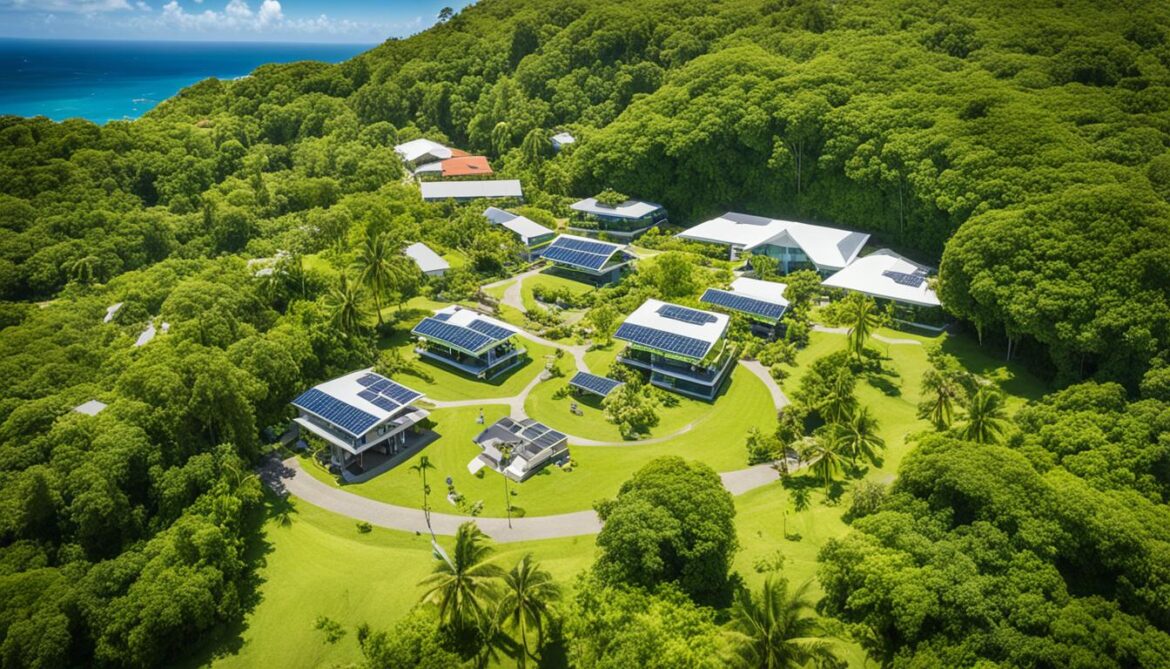
As illustrated by the table above and supported by the numerous benefits discussed, green buildings in Tobago and environmentally-friendly structures in Trinidad contribute to a more sustainable and resilient built environment. They represent a commitment towards a greener future, where energy efficiency, occupant well-being, and environmental stewardship are prioritized.
Challenges and Opportunities
While there is a growing interest in green buildings, there are challenges to their widespread adoption. The cost of building green can be high, and there is a lack of regional green certification for buildings. However, there are opportunities to overcome these challenges by providing government incentives, promoting green policies, and raising awareness about the long-term benefits of green buildings. Green infrastructure and construction practices can also be incorporated to further enhance sustainability efforts.
In order to accelerate the adoption of green construction practices in Tobago and promote green infrastructure in Trinidad and Tobago, it is important to address the following challenges:
- The Cost Barrier: Building green often requires higher upfront costs compared to conventional construction methods. These costs can deter developers and homeowners from investing in green buildings. However, by providing government incentives such as tax credits or grants, the financial burden can be alleviated, making green building more accessible and financially viable for all stakeholders.
- Lack of Regional Green Certification: Currently, there is a lack of a standardized, regionally recognized green building certification system in Trinidad and Tobago. This absence makes it difficult for developers to showcase their sustainable practices and for consumers to identify green buildings. Implementing a regional green certification program would not only validate sustainable construction practices but also help educate the public about the environmental and economic benefits of green buildings.
- Awareness and Education: Raising awareness about the long-term benefits of green buildings is essential to encourage their adoption. Public education campaigns, workshops, and seminars can help inform the public about the advantages of green construction practices in Tobago and the importance of sustainable infrastructure in Trinidad and Tobago. By highlighting the energy and cost-saving potential of green buildings, more individuals and organizations may be encouraged to invest in sustainable construction.
Overcoming these challenges presents significant opportunities for the green building industry in Trinidad and Tobago. By embracing green construction practices in Tobago and promoting green infrastructure in Trinidad and Tobago, the following benefits can be realized:
- Environmental Protection: Green buildings have a lower environmental footprint, reducing carbon emissions and conserving natural resources. By integrating sustainable materials and energy-efficient technologies, green buildings contribute to a cleaner and healthier environment.
- Economic Growth and Job Creation: The green building sector has the potential to stimulate economic growth and create jobs. As demand for sustainable construction practices increases, there will be opportunities for skilled workers, architects, engineers, and other professionals in the construction industry.
- Improved Quality of Life: Green buildings prioritize occupant health and well-being. They provide better indoor air quality, natural lighting, and thermal comfort, leading to improved productivity and general well-being for building occupants.
To fully harness the benefits of green construction practices in Tobago and capitalize on the potential of green infrastructure in Trinidad and Tobago, it is crucial for stakeholders to collaborate and take action. By implementing supportive policies, providing incentives, and raising awareness, Trinidad and Tobago can accelerate the transition towards a sustainable built environment.
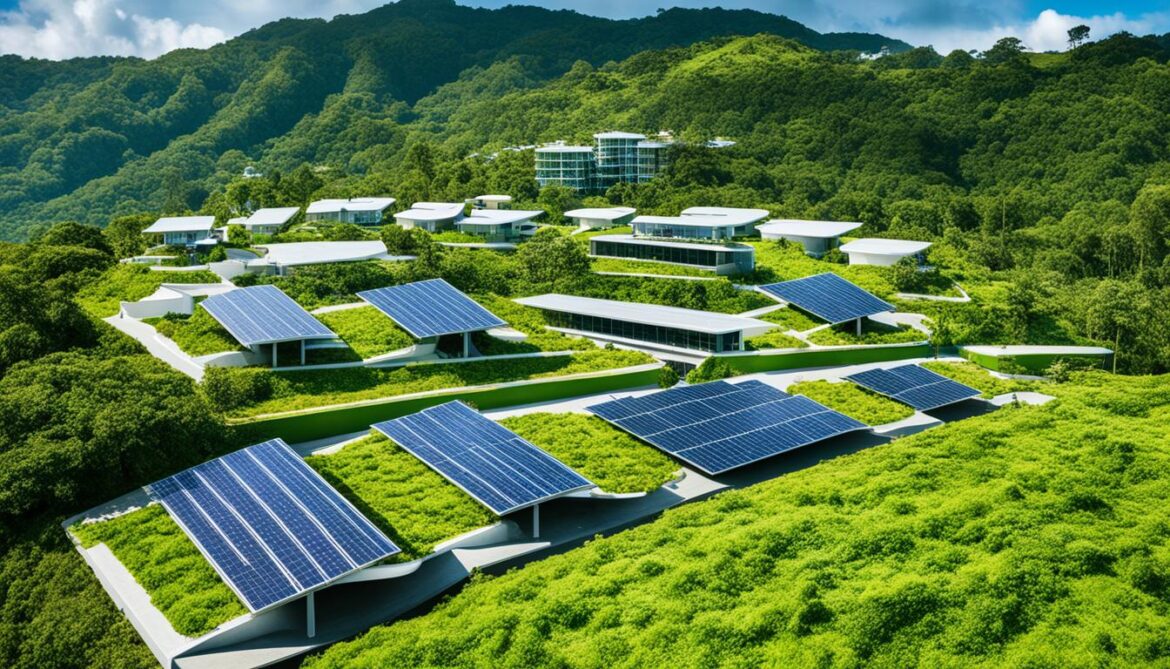
Retrofitting Existing Buildings
Retrofitting existing buildings is a viable option to make them greener. By implementing energy-efficient measures such as replacing appliances, installing LED bulbs, using natural ventilation, and optimizing shading, existing buildings can reduce their energy consumption. Incorporating green design principles in the renovation process, such as incorporating sustainable materials and integrating outdoor spaces, can further enhance the sustainability of existing buildings.

When it comes to making existing buildings more environmentally friendly, retrofitting offers a practical solution. By upgrading and improving the energy efficiency of existing structures, we can reduce their carbon footprint and contribute to a more sustainable future.
Eco-friendly Upgrades
During the retrofitting process, several energy-efficient upgrades can be implemented to lower energy consumption and reduce environmental impact. Here are some key measures that can be taken:
- Replacing outdated appliances and equipment with energy-efficient models
- Installing LED lighting systems to reduce electricity usage
- Implementing natural ventilation strategies to decrease reliance on air conditioning
- Optimizing shading elements to minimize heat gain and reduce cooling needs
Integrating Sustainable Design
Integrating sustainable design principles into the retrofitting process can further enhance the environmental performance of existing buildings. This involves using sustainable materials and practices that prioritize resource conservation and promote a healthier indoor environment.
By incorporating sustainable materials such as recycled content, low-impact paints, and eco-friendly insulation, existing buildings can become more eco-conscious and contribute to a greener Trinidad and Tobago.
Furthermore, the integration of outdoor spaces, such as green roofs or vertical gardens, can enhance the building’s aesthetic appeal while improving air quality and reducing the urban heat island effect.
The Benefits of Retrofitting
The benefits of retrofitting existing buildings extend beyond environmental considerations. Retrofitting can also lead to financial savings for building owners and occupants. By reducing energy consumption, utility bills can be significantly reduced, providing long-term cost savings.
In addition, retrofitting existing buildings aligns with the sustainable development goals of Trinidad and Tobago, promoting a more resilient and environmentally responsible built environment.
Cost-Saving Retrofit Measures
| Retrofit Measure | Projected Cost Savings | Environmental Impact |
|---|---|---|
| LED Lighting Installation | Up to 70% reduction in lighting energy costs | Significant reduction in carbon emissions |
| Installing Energy-Efficient Appliances | Up to 50% reduction in energy consumption | Reduces reliance on fossil fuels |
| Natural Ventilation Strategies | Up to 30% reduction in cooling costs | Decreases energy demand and carbon footprint |
| Sustainable Material Integration | Varies based on materials chosen | Reduces resource consumption and waste generation |
Implementing these retrofit measures not only contributes to a more sustainable future but also demonstrates the commitment of Trinidad and Tobago to environmental stewardship.
Role of the Government and Regulations
The government plays a pivotal role in promoting green buildings in Trinidad and Tobago. By implementing green building codes and providing incentives, they encourage developers and homeowners to adopt sustainable practices. Government support and regulations are instrumental in driving the transition towards a more sustainable built environment.
The implementation of green building regulations in Trinidad ensures that construction projects adhere to sustainable practices. These regulations set guidelines for energy efficiency, water conservation, and the use of environmentally-friendly materials. By enforcing these regulations, the government ensures that new buildings contribute to a greener future for the country.
In addition to regulations, the government also provides green incentives in Tobago to encourage the adoption of sustainable practices. These incentives can take the form of tax relief or rebates for builders, developers, and homeowners who incorporate green elements into their projects. By offering financial benefits, the government incentivizes the investment in eco-friendly building solutions.
| Government Initiatives | Description |
|---|---|
| Tax Relief | The government offers tax relief for developers and homeowners who invest in energy-efficient systems and materials. |
| Rebates | Builders and homeowners can receive rebates for utilizing renewable energy sources, such as solar panels or wind turbines. |
| Incentive Programs | The government establishes incentive programs to encourage the construction of green buildings and the use of sustainable practices. |
The government’s role extends beyond incentives and regulations. They must also lead by example and incorporate green policies in public projects. By integrating sustainable design principles into government-owned buildings and infrastructure, they set a precedent for private developers and inspire the wider community to embrace sustainable practices.
With government support and the right set of regulations and incentives, Trinidad and Tobago can accelerate the adoption of green building practices. It is an essential step towards creating a more sustainable and resilient built environment in the country.
Success Stories
Trinidad and Tobago has seen remarkable success in the implementation of green building projects, showcasing the potential of sustainable design and construction in the region. These projects not only prioritize environmental conservation but also prioritize the well-being and comfort of the occupants. Two standout examples of successful green building projects in Trinidad and Tobago are the Ministry of Information building in Port of Spain and the National Library, also located in Port of Spain.
The Ministry of Information building in Port of Spain is a prime example of sustainable architecture and design. It incorporates various green features and technologies to minimize its environmental impact and maximize energy efficiency. The building utilizes optimal shading techniques, allowing for natural ventilation and reduced reliance on artificial cooling. Furthermore, the use of energy-efficient lighting and appliances contributes to the overall sustainability of the building. Rainwater harvesting systems and water-conserving fixtures are also implemented, reducing water consumption and promoting sustainable water management.
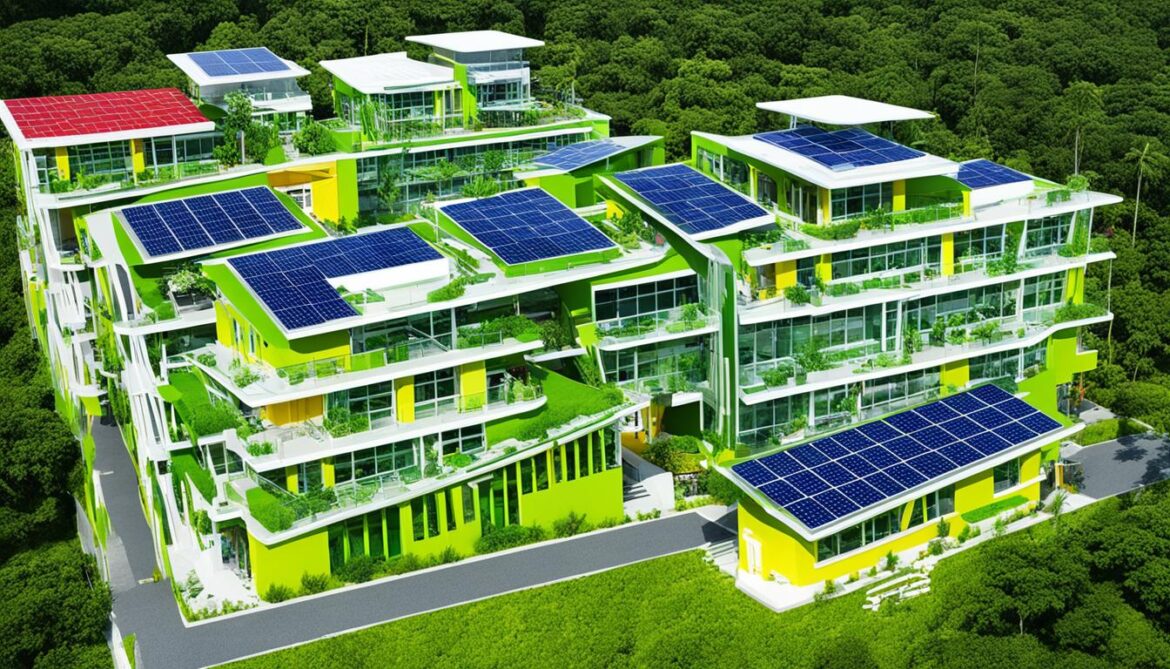
The National Library, also located in Port of Spain, is another notable green building project in Trinidad and Tobago. It boasts a design that maximizes the use of natural lighting and ventilation, reducing the need for artificial lighting and air conditioning. The building incorporates ample green spaces, providing a tranquil environment for visitors while promoting biodiversity within an urban setting. Furthermore, the National Library showcases the use of locally sourced materials, supporting the local economy and reducing the carbon footprint associated with long-distance transportation.
These exemplary green building projects in Trinidad and Tobago demonstrate the viability and benefits of sustainable design and construction in the Caribbean region. They serve as inspiring case studies for future green building initiatives and underscore the importance of incorporating environmentally conscious practices into architectural projects.
Economic and Environmental Impacts
Green buildings have significant economic and environmental benefits. They not only contribute to energy savings but also reduce operating costs for building owners and occupants. By incorporating energy-efficient design and technologies, green buildings can achieve substantial reductions in energy consumption, leading to long-term financial savings.
In addition to economic advantages, green buildings also play a crucial role in reducing carbon emissions in Trinidad and Tobago. By implementing sustainable construction practices and utilizing renewable energy sources, these buildings help mitigate the impacts of climate change. The reduction in carbon emissions contributes to the preservation of the natural environment and the promotion of a healthier and more sustainable future.
One of the key economic benefits of green buildings is the creation of jobs in the construction and renewable energy sectors. The implementation and maintenance of energy-efficient systems, such as solar panels and efficient building materials, require skilled professionals, thus generating employment opportunities in these industries. This not only supports the local economy but also fosters a sustainable workforce that contributes to the growth and development of the country.
Beyond the economic benefits, green buildings also have a positive impact on the health and well-being of occupants. By promoting indoor air quality, optimizing natural light, and incorporating green spaces, these buildings create healthier and more comfortable living and working environments. This, in turn, improves the productivity and overall satisfaction of occupants.
“The economic and environmental impacts of green buildings are significant. They not only reduce energy consumption and carbon emissions but also create jobs and foster healthier living spaces for occupants.” – Dr. Samantha Clarke, Environmental Scientist
Economic Benefits of Green Buildings
The economic benefits of green buildings can be summarized as follows:
| Benefits | Description |
|---|---|
| Energy savings | Energy-efficient design and technologies lead to reduced energy consumption and lower utility bills for building owners and occupants. |
| Cost savings | By reducing operating expenses, green buildings offer long-term cost savings in terms of maintenance, repairs, and utility expenses. |
| Job creation | The construction and renewable energy sectors experience increased demand for skilled workers, creating employment opportunities. |
Environmental Benefits of Green Buildings
The environmental benefits of green buildings include:
- Carbon emissions reduction: Green buildings help reduce carbon emissions through energy-efficient measures and the use of renewable energy sources.
- Conservation of resources: Sustainable building practices minimize the consumption of water, materials, and natural resources.
- Protection of ecosystems: Green buildings contribute to the preservation of natural habitats and ecosystems by reducing environmental impacts.
By capitalizing on the economic and environmental benefits of green buildings, Trinidad and Tobago can pave the way for a sustainable future while creating a thriving economy and a healthier environment for its citizens.
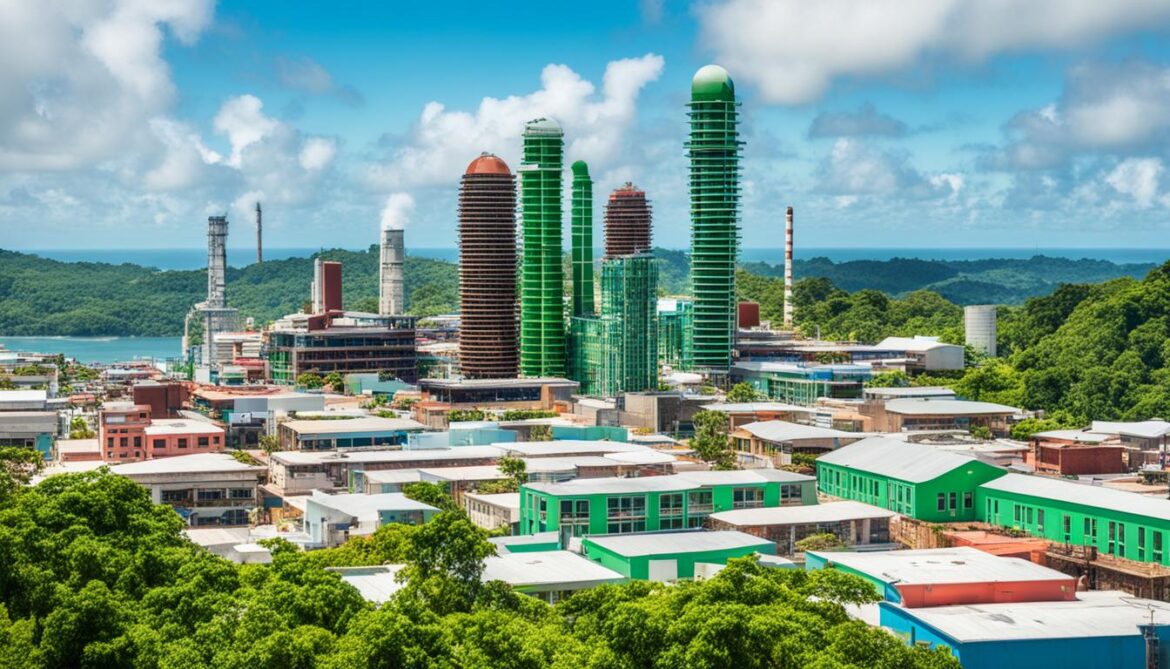
The Future of Green Buildings in Trinidad and Tobago
The sustainable development of Trinidad and Tobago is gaining momentum, bringing with it advancements in green architecture. With increasing awareness and interest in sustainable practices, the future of green buildings in Trinidad and Tobago looks promising. Through government support, increased investment, and collaboration among various stakeholders, the adoption of green building practices is expected to accelerate, resulting in a more sustainable and resilient built environment.
Green architecture encompasses innovative design techniques, sustainable construction materials, and energy-efficient technologies. These advancements are being integrated into new building projects, as well as retrofitting existing structures, promoting a greener and more environmentally-friendly approach to construction.
The commitment to sustainable development in Trinidad and Tobago is evident in the government’s efforts to promote green building practices. By implementing regulations and providing incentives, such as tax relief and rebates, the government is encouraging developers and homeowners to embrace sustainable design principles and practices. As a result, the number of green buildings in the country is expected to increase in the coming years.
“Sustainable development is not just a buzzword, but a necessity for the future of our planet. Green buildings play a crucial role in creating a greener and more sustainable Trinidad and Tobago.” – Mark Johnson, Minister of Environment and Sustainable Development
The future of green buildings in Trinidad and Tobago also relies on continued investment in research and development. By investing in sustainable technologies and building practices, the country can stay at the forefront of green architecture and contribute to global efforts in combating climate change.
The growing popularity of green buildings presents numerous opportunities for stakeholders in the construction industry. Architects, engineers, and developers who specialize in sustainable design and construction are in high demand. This trend also stimulates job growth and economic development in related industries, such as renewable energy and environmental consulting.
The Economic Benefits of Green Buildings
Green buildings not only promote environmental sustainability but also offer significant economic benefits. By reducing energy consumption and operating costs, these buildings provide long-term savings for both owners and occupants. Energy-efficient design features, such as solar panels and efficient insulation, help lower utility bills and decrease reliance on fossil fuels.
Additionally, green buildings enhance indoor air quality and occupant comfort, leading to improved productivity and well-being. Studies have shown that occupants of green buildings experience fewer health issues and higher job satisfaction compared to those in conventional buildings.
The Environmental Impact of Green Buildings
The environmental impact of green buildings cannot be overstated. By incorporating sustainable design principles and utilizing renewable energy sources, these buildings significantly reduce carbon emissions and resource consumption.
In Trinidad and Tobago, where climate change and sea-level rise are significant concerns, green buildings play a vital role in mitigating these effects. They contribute to the country’s commitment to reducing its carbon footprint and protecting the natural environment for future generations.
To illustrate the impact of green buildings, consider the following table:
| Environmental Impact | Green Buildings | Conventional Buildings |
|---|---|---|
| Energy Consumption | Significantly lower | Higher |
| Carbon Emissions | Reduced | Higher |
| Resource Consumption | Minimal | Higher |
| Waste Generation | Minimal | Higher |
As shown in the table, green buildings have a significantly lower environmental impact compared to conventional buildings. This reinforces the importance of adopting sustainable building practices to create a greener and more sustainable future.
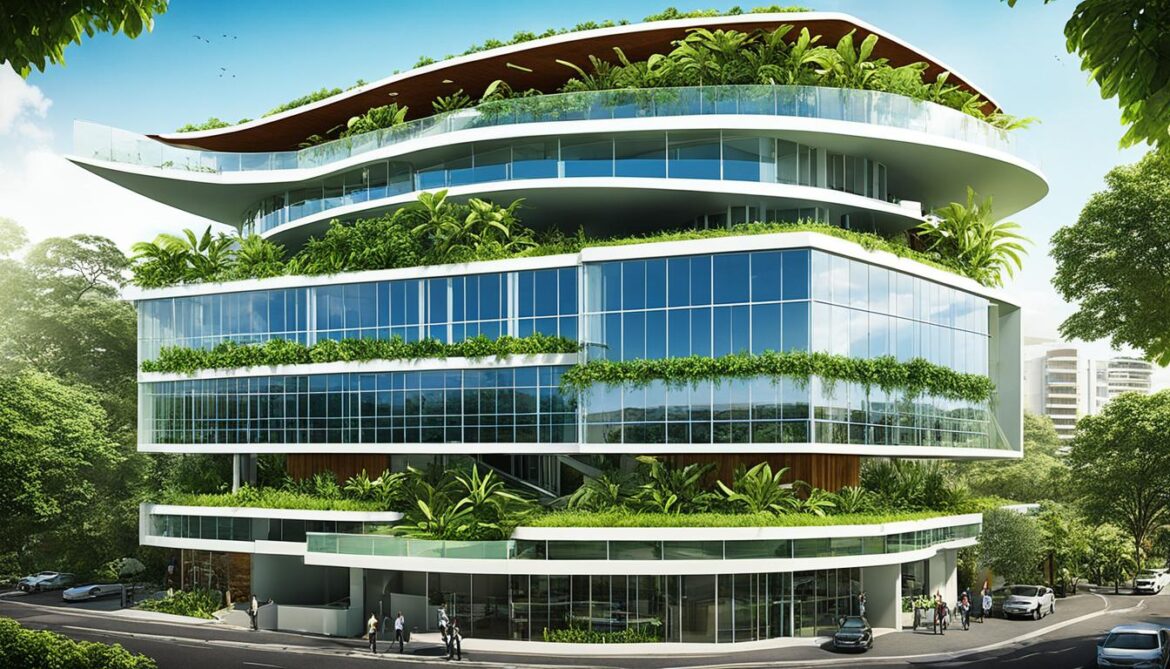
The image above highlights the advancements in green architecture driving the future of sustainable development in Trinidad and Tobago.
Conclusion
Green buildings play a crucial role in creating a sustainable future for Trinidad and Tobago. By prioritizing energy efficiency, water conservation, and sustainable design, these buildings contribute significantly to reducing carbon emissions and protecting the environment. With ongoing efforts to promote green building practices, Trinidad and Tobago can continue to set an example for other countries in the Caribbean region, establishing itself as a leader in sustainable architecture.
The incorporation of green building features, such as advanced insulation, efficient lighting systems, and renewable energy sources, not only reduces the environmental impact but also helps to create healthier and more comfortable living and working spaces for the people of Trinidad and Tobago. These buildings prioritize the use of sustainable materials, harness natural resources, and optimize energy consumption, resulting in long-term cost savings for building owners and occupants.
Furthermore, green buildings provide the opportunity to enhance the resilience of Trinidad and Tobago’s built environment in the face of climate change. With rising concerns about the impact of extreme weather conditions, such as hurricanes and rising sea levels, green buildings can play a vital role in ensuring the safety and welfare of residents.
As the demand for green buildings continues to grow, it is important for Trinidad and Tobago to maintain its commitment to sustainable development. By fostering collaboration among architects, engineers, policymakers, and the public, the country can drive innovation in sustainable design and construction practices. With the support of the government and the active involvement of stakeholders, Trinidad and Tobago has the potential to lead the way in creating a greener, more sustainable future.




